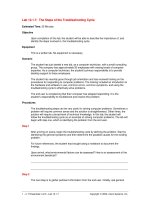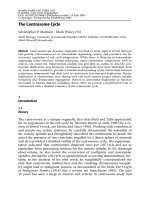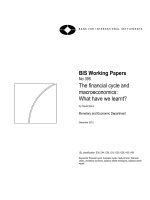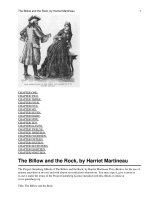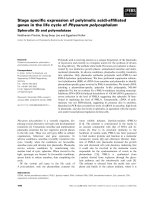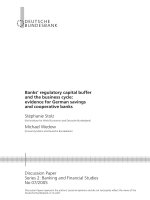The rock cycle clastic sedimentary rocks
Bạn đang xem bản rút gọn của tài liệu. Xem và tải ngay bản đầy đủ của tài liệu tại đây (2.05 MB, 25 trang )
EARTH MATERIALS VI
The Rock Cycle:
Clastic Sedimentary Rocks
Professor Peter Doyle
THE ROCK CYCLE
Relative proportions of rock groups
Sedimentary rocks:
larger proportion of
land surface
The greater
proportion created
by weathering,
erosion & deposition
These are known as
clastic sediments
SEDIMENTARY ROCKS
• Clastic sediments from weathering & erosion
of pre- existing rocks
• Weathering can be physical (freeze-thaw) or
chemical
• Erosion & subsequent transportation by
water, wind and ice before deposition
• Biogenic and chemical sediments form as
biochemical or inorganic chemical precipitates
• E.g. shelly fragments in limestones; evaporites
Sediments to sedimentary rocks
Weathering structures
seen in ancient
terranes
Lithification due to:
1. Compaction
(squeezing out water)
2. Diagenesis
(precipitation of
cements)
Transport shown by
sedimentary structures
Mineralogy of sedimentary rocks
Clastic sediments
• siliciclastics – quartz, feldspars, clay
minerals, rock fragments
• calciclastics – calcite, dolomite
Carbonate (biogenic) sediments
• aragonite, calcite
• chalcedony silica (flint) occurs as subsiduary
Evaporite (chemical) sediments
• halite, gypsum and anhydrite
• Dolomite, also as dolomitisation of calcite
Classification of clastic sediments: The
Wentworth Scale
Grain Size Sediment Grade
>256 mm
256 – 64mm
64 – 2mm
2 – 0.063mm
0.063 – 0.002mm
< 0.063mm
< 0.002mm
Rock
Boulder
Cobble
Pebble
Conglomerate
(rounded clasts)
Breccia
(angular clasts)
Sand
Silt
Mud
Clay
Sandstone
Siltstone
Mudstone / Shale
Claystone
Conglomerates & Breccias
• Conglomerates - mainly rounded clasts
–
–
Ortho conglomerates - clast supported
Para conglomerates - matrix supported
• Breccias - mainly angular clasts
• Clast type defines rock type:
– Monomict - clasts of mainly one composition
– Polymict - clasts of various compositions
– Diamict - clasts poorly sorted of various types
• Matrix (sediment between major clasts)
– sand and mud grade sediments
• Cement binds clasts/matrix (Crystalline,
diagenetic, typically calcite, silica
Finer grains between
major clasts
Grains floating in matrix
Crystalline
cement
Grains touching
Ca
lc
i
te
ce
m
Quartz clast
en
t
Diamict conglomerate
Orthoconglomerate
Monomict breccia
SANDSTONES
• CLASTS have modal grain size in the sand
grade ( 2mm – 0.063mm)
– Coarse sand 2- 0.5mm,
– medium 0.5-0.25m
– fine 0.25 - 0.063mm
• Siliciclastic sands have clasts composed
usually of quartz, feldspar, fine grained rock
fragments or lithics
• Mud grade matrix may be present
• Crystalline diagenetic cements, e.g. quartz,
calcite, clay minerals
Maturity
• Maturity is a function of sediment transport
• Textural maturity refers to:
– The degree of roundness of the grains
– The amount of sorting of the grain sizes
• Texturally mature sandstones have well-rounded
and well-sorted grains, immature if not
• Mineralogical maturity refers to the percentage of
quartz grains
– Feldspars break down with transport
– Quartz grains more resistant
• Mineralogically mature sandstones have mostly
quartz grains
• Arkose is mineralogically immature
Roundness
Dry aeolian
(airborne) grains
Well-rounded &
heavily abraded
Increasing Roundness=increasing maturity
Sorting
Well sorted
Poorly sorted
Increasing sorting=increasing maturity
Transport structures
Cross-bedding
Ripples
Mineralogy
Increasing quartz=increasing maturity
Classifying sandstones: mineralogy
Quartz
>95% Quartz =
Quartz arenite
<95% Quartz divided on
amount of
feldspar or lithics
Feldspar
Rock
fragments
(lithics)
Arkose
>25% Feldspar = arkosic composition
>25% Feldspar = mineralogically
immature
Quartz
Feldspar
Lithics
PETTIJOHN CLASSIFICATION
Based on percentage of
matrix
• Matrix poor (<15%) - arenites
• Matrix rich (>15%) – wackes
• Wackes or (greywackes)
• Tend to be dark in colour
• Are poorly sorted
Examples in hand specimen
Light
Light coloured
coloured
Dark coloured
Light coloured
Dark coloured
Cross-bedded
sandstone
Red sandstone
Polished sandstone
Lithic sandstone
Quartz sandstone (arenite)
Fine grained siliciclastic rocks
• Modal grain size <0.063mm
• Grouped as Mudrocks (>50% siliclastic
grains, <0.063mm)
• Typical mineralogy
–
–
Clay minerals (sheet silicates),
quartz & feldspar
• MUDROCKS may split (fissile) or not
(massive)
• Siltstones non-fissile, coarser grade, mica
flakes common
• Mudstones - massive, mud-grade
• Shales - Fissile (splitting), mud-grade
Siliciclastic rocks
QuickTime™ and a
TIFF (Uncompressed) decompressor
are needed to see this picture.
Increasing mudgrade grains
Shale
